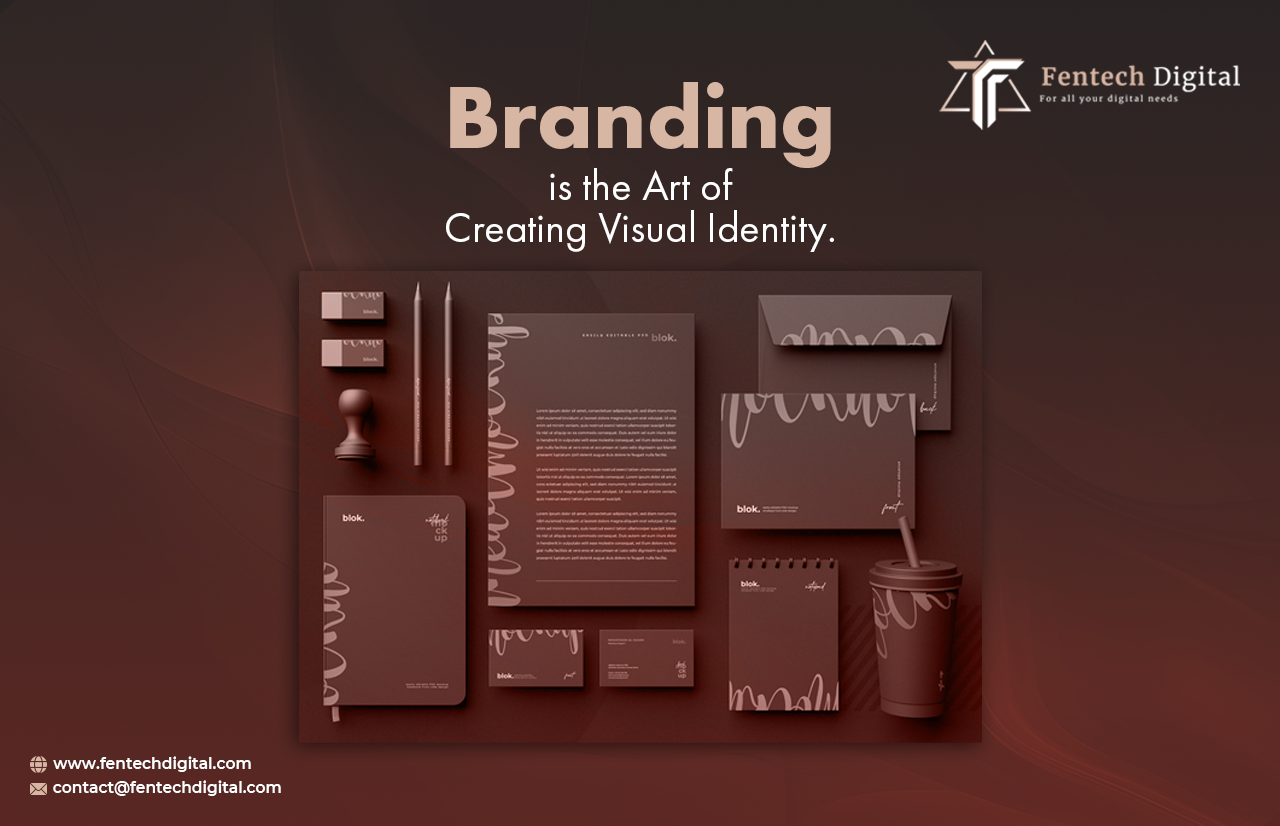Branding
May 25, 2024

Introduction:
Branding refers to the process of creating and establishing a unique identity, image, or reputation for a product, service, or business. It encompasses various elements such as:
- Logo and visual design
- Tone and voice
- Messaging and positioning
- Personality and values
- Customer experience and engagement
Branding aims to differentiate a brand from its competitors, build recognition and loyalty, and create an emotional connection with its target audience. A strong brand can:
- Increase customer loyalty and retention
- Drive business growth and revenue
- Enhance credibility and trust
- Support marketing and advertising efforts
- Create a lasting impression and reputation
Effective branding involves understanding your target audience, crafting a clear brand strategy, and consistently communicating your brand message across all touchpoints and channels.
Concepts of Branding:
The basic concept of branding involves creating a unique identity for a product, service, or business that differentiates it from others and creates an emotional connection with its target audience. The key elements of branding include:
- Unique Value Proposition (UVP): Clearly defining what sets your brand apart from others.
- Target Audience: Identifying the specific group of people your brand is intended for.
- Brand Personality: Defining the tone, voice, and character of your brand.
- Visual Identity: Creating a consistent visual language, including logos, colors, and typography.
- Brand Messaging: Crafting a clear and concise message that resonates with your target audience.
- Consistency: Ensuring that all brand elements are consistent across all touchpoints and channels.
- Emotional Connection: Creating an emotional bond with your target audience to build loyalty and advocacy.
By focusing on these basic concepts, you can establish a strong brand foundation that sets your business up for success.
Purpose of Branding:
The purpose of branding is to create a unique identity, image, and reputation for a business, product, or service that differentiates it from others and resonates with its target audience. The benefits of branding to a business include:
- Differentiation: Branding helps a business stand out from its competitors and establish a unique presence in the market.
- Recognition: A strong brand identity makes a business more recognizable and memorable, increasing the likelihood of customer loyalty and retention.
- Trust and Credibility: A well-established brand can build trust and credibility with its target audience, leading to increased sales and customer loyalty.
- Emotional Connection: Branding helps create an emotional connection with customers, fostering a sense of belonging and loyalty.
- Consistency: Branding ensures consistency in messaging, visual identity, and tone across all touchpoints and channels.
- Marketing Efficiency: A strong brand makes marketing efforts more efficient, as the brand’s message and identity are already established.
- Employee Engagement: A clear brand purpose and identity can inspire and engage employees, boosting morale and productivity.
- Business Value: A strong brand can increase a business’s value, making it more attractive to investors, partners, and potential buyers.
- Customer Loyalty: Branding helps build customer loyalty, encouraging repeat business and positive word-of-mouth.
- Long-term Growth: A well-established brand can support long-term growth and expansion into new markets and industries.
Investing in branding, businesses can create a lasting impression, build a loyal customer base, and drive long-term success.
Unique Value Proposition (UVP):
Defining your brand’s Unique Value Proposition (UVP) involves identifying the unique benefits, advantages, and values that your brand offers to customers. Here’s a step-by-step process to help you define your UVP:
- Identify your target audience: Understand who your ideal customer is, their needs, desires, and pain points.
- Conduct a competitor analysis: Research your competitors, their strengths, and weaknesses.
- Determine your brand’s purpose: Define your brand’s mission, vision, and values.
- Identify your brand’s unique benefits: List the benefits that your brand offers to customers, such as quality, convenience, innovation, or expertise.
- Prioritize and refine: Prioritize the benefits and refine them into a clear and concise statement.
- Craft your UVP statement: Combine the benefits into a single statement that clearly communicates your brand’s unique value.
Example of a UVP statement:
“(Brand Name) helps (target audience) achieve (desired outcome) by providing (unique benefit 1), (unique benefit 2), and (unique benefit 3) that (key differentiator).”
Key elements of a UVP statement:
- Target audience: Clearly defines who the brand serves.
- Desired outcome: Identifies the specific outcome or benefit the customer wants.
- Unique benefits: Lists the unique advantages the brand offers.
- Key differentiator: Highlights what sets the brand apart from others.
Example:
“Nike helps athletes and fitness enthusiasts achieve their performance goals by providing innovative, high-quality, and stylish athletic wear that is designed to help them perform at their best.”
By following these steps, you can define a clear and compelling UVP that resonates with your target audience and differentiates your brand from competitors.
Visual Identity:
A brand’s visual identity consists of the visual elements that represent a brand, and it is crucial for creating recognition, differentiation, and emotional connection with the target audience. The key elements of a brand’s visual identity include:
- Logo: A unique symbol or icon that represents the brand.
- Color Palette: A selection of colors that reflect the brand’s personality and values.
- Typography: A specific font or font style used consistently across all touchpoints.
- Imagery: A consistent style of images, graphics, and photography used to communicate the brand’s message.
- Iconography: A set of icons and graphics used to support the brand’s messaging.
- Patterns and Textures: Repeating patterns or textures used to add depth and visual interest.
- Stationery and Marketing Materials: Business cards, letterheads, brochures, and other marketing materials that showcase the brand’s visual identity.
These elements are important because they:
- Create Recognition: A consistent visual identity helps customers recognize and remember the brand.
- Differentiate: A unique visual identity sets the brand apart from competitors.
- Emotional Connection: Visual elements can evoke emotions and create an emotional connection with the target audience.
- Consistency: A consistent visual identity ensures that all touchpoints and communications have a cohesive look and feel.
- Professionalism: A well-designed visual identity conveys a sense of professionalism and credibility.
- Brand Storytelling: Visual elements can help tell the brand’s story and communicate its values and personality.
Target Audience:
Determining your target audience involves understanding who your ideal customer is, what their needs and pain points are, and what motivates them to make purchasing decisions. Here are some steps to help you determine your target audience:
- Conduct market research: Gather data and insights from various sources, such as industry reports, customer surveys, social media, and online analytics.
- Identify demographics: Consider age, gender, income level, occupation, education level, and other demographic factors that might be relevant to your business.
- Analyze psychographics: Look at values, interests, attitudes, and lifestyle choices that might influence purchasing decisions.
- Examine customer behavior: Study buying habits, purchase history, and loyalty patterns.
- Create buyer personas: Develop detailed profiles of your ideal customers, including their goals, challenges, and motivations.
- Segment your audience: Divide your target audience into distinct groups based on shared characteristics, needs, or behaviors.
- Validate your findings: Test your assumptions through feedback, surveys, or focus groups to ensure you’re targeting the right audience.
Brand Personality:
Brand personality refers to the human-like qualities and characteristics that a brand exhibits, such as its values, attitude, and tone. It’s the way a brand communicates and interacts with its audience, creating an emotional connection and building a relationship.
To develop a consistent tone and voice for your brand, follow these steps:
- Define your brand’s purpose and values: Establish a clear understanding of your brand’s mission, vision, and values.
- Identify your target audience: Understand who your ideal customer is, their needs, and preferences.
- Determine your brand’s personality traits: Based on your purpose, values, and target audience, define the personality traits that best represent your brand, such as friendly, professional, humorous, or empathetic.
- Develop a tone and voice charter: Create a document that outlines the tone and voice guidelines for your brand, including the language, syntax, and tone to use in different communication channels.
- Use language and tone consistently: Apply the tone and voice charter across all marketing materials, social media, customer service, and employee communications.
- Train your team: Ensure all employees and representatives understand and can embody the brand’s personality, tone, and voice.
- Monitor and adjust: Continuously monitor how your brand’s tone and voice are perceived and make adjustments as needed to maintain consistency and relevance.
Some key considerations when developing your brand’s tone and voice include:
– Authenticity: Be true to your brand’s purpose and values.
– Consistency: Use the same tone and voice across all channels.
– Relevance: Adapt your tone and voice to resonate with your target audience.
– Emotional connection: Use language that evokes emotions and builds a connection with your audience.
By developing a consistent tone and voice, you’ll create a strong brand personality that resonates with your audience and sets you apart from competitors.
Conclusion:
In conclusion, branding is a crucial aspect of business that helps create a unique identity, builds recognition, and establishes an emotional connection with the target audience. To develop a strong brand, it’s essential to:
- Define your brand’s purpose, values, and unique value proposition (UVP).
- Determine your target audience and understand their needs, preferences, and pain points.
- Develop a consistent visual identity, including a logo, color palette, typography, and imagery.
- Create a brand personality and tone of voice that resonates with your audience.
- Ensure consistency across all touchpoints and channels.
- Monitor and adjust your branding strategy as needed to stay relevant and competitive.
By following these steps, you’ll be able to establish a strong brand that sets your business up for success and helps you achieve your goals.
Remember, branding is an ongoing process that requires continuous effort and attention. Stay focused on your brand’s purpose, values, and target audience, and make adjustments as needed to maintain a strong and relevant brand identity.

